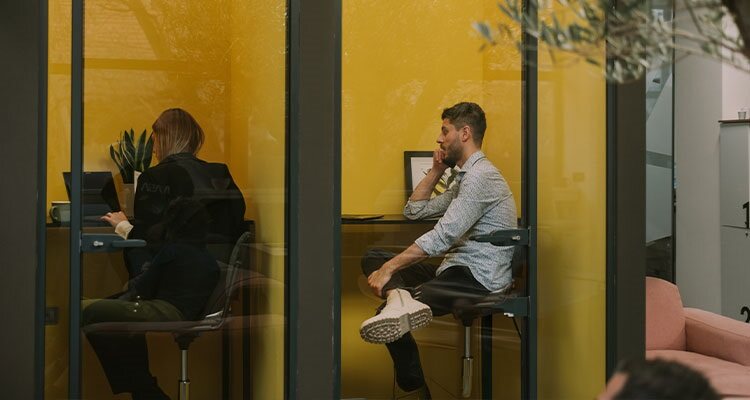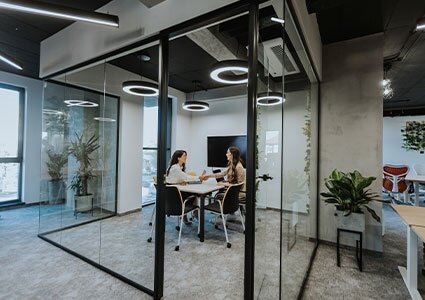
Matisen Anders and Jeffrey Chiu highlight the unassuming versatility of phone booths in the built environment
Privacy booths, or phone booths, are an adapted technology developed to accommodate an ever-changing commercial landscape. As open office spaces rise in popularity to foster internal collaboration, quiet spaces for phone calls and virtual meetings remain necessary. Privacy booths supply an innovative solution for creating a private, acoustically insulated space. However, they face challenges in the approval process for building owners, tenants, architects, booth manufacturers, and authorities having jurisdiction (AHJs).
Privacy booths in the built environment
Privacy booths have become a staple in many occupancies worldwide, including offices and airports. Increasingly available in a variety of styles, materials, and sizes, privacy booths are designed to support operational goals across an agile environment while offering an attractive alternative to adapting traditional ‘stick-built’ construction. Booths range in size to accommodate a single user for virtual or phone meetings or accommodate multiple users up to the size of a small conference room.
Despite their mass, many booths are proposed as furniture due to their intended mobility. However, privacy booths are more comparable to rooms, creating an enclosed space, and therefore require a level of safety consistent with the remainder of the building. Establishing consistent code considerations for installing privacy booths can help streamline evaluations and ensure the safety and resiliency of the built environment.
Privacy booth safety and applicable codes
When implementing privacy booths, addressing fire and nonstructural life safety requirements of the 2021 edition of the International Building Code (IBC) is necessary. While the following is not an exhaustive discussion of all potentially applicable codes and standards, this serves as a basis for understanding some of the crucial requirements.
- Finishes and textiles: interior finishes and textile wall coverings throughout a booth are potential fire hazards. Interior wall and ceiling finishes and textile wall and ceiling coverings are to meet flame spread indexes when tested in accordance with ASTM E84 or UL 723 (IBC §803.1.2, §803.5.2). Interior floor finishes are to meet critical radiant flux limits when tested in accordance with ASTM E648 or NFPA 253 (IBC §804.4.2).
- Occupant egress: ease of egress can improve occupant safety during an emergency significantly. Doors are to have a clear opening width of 32 inches but are permitted to be reduced to 20 inches when serving nonaccessible, single-user spaces (IBC §1010.1.1, Ex. 11). Although the clear width is intended to support occupants in wheelchairs, door width impacts the dimensions of the booth.
During emergency egress, landing size is intended to accommodate maneuverability when operating doors, while landing elevation and threshold height are intended to prevent trip hazards. A floor or landing is to be provided at the same elevation on both sides of a door (IBC §1010.1.4), with a width not less than the door’s width and a length not less than 44 inches measured in the direction of travel (IBC §1010.1.5). Threshold heights are limited to one-half inch above the finished floor (IBC §1010.1.6). These requirements impact the floor dimensions of the booth.
- Sprinkler protection: for a building to be considered equipped throughout with an automatic sprinkler system and apply allowances permitted by codes for sprinklered buildings, sprinklers must be provided within all areas of the building (IBC §903.3.1.1). Typically, sprinklers are required within privacy booths. However, when approved by the jurisdiction, sprinkler protection may not be required in small temporarily occupied enclosures if the enclosure does not extend to the ceiling, does not exceed 24 square feet, and is physically isolated from other booths by open space (2022 NFPA 13 §9.2.10).
When installing a booth, placement in the building must be considered, as the booth height may obstruct a sprinkler and prevent the sprinkler from operating as intended. Sprinkler obstructions are not permitted within 18 inches vertical clearance or 4 feet horizontal clearance (2022 NFPA 13 §9.5.5.2.1). - Notification appliances: due to the nature of privacy booths and their acoustic insulation, notification appliances installed outside a booth may not provide sufficient coverage for occupants within. Audible notification is to be at least 15 dB above the average ambient sound level or 5 dB above the maximum prolonged sound level (IBC §907.5.2.1.1, 2022 NFPA 72 §18.4.4.1). Sound attenuation may require installation of an audible notification appliance within the booth to achieve minimum sound pressure. Additionally, multi-user booths require a visual notification appliance inside the booth consistent with other common-use areas (IBC §907.5.2.3.1).
Making safety a priority
These are a few fire and nonstructural life safety code requirements to consider when installing privacy booths. Additional considerations often include structural or seismic anchorage, mechanical ventilation, electrical reliability, and accessibility.
The need for occupant safety in buildings worldwide does not diminish as technology adapts to accommodate operational goals. By keeping these code requirements in mind, we can stay current with an ever-changing construction landscape and contribute to a safe and resilient built environment.
www.jensenhughes.com
Matisen Anders, PE (CE, FPE), PMP, is a Senior Consultant for fire and building safety at Jensen Hughes. Her expertise in building construction and design extends to the application of life safety codes, including NFPA, IBC and California Building Codes, code compliance review, egress analysis, alternative design requests, property condition assessments, and life safety code assessment surveys.
Jeffrey Chiu, EIT, is a Fire Safety Code Consultant at Jensen Hughes, providing code consulting on large assembly occupancies, high-rise residential, commercial office buildings, healthcare, educational, laboratory, and hotel/resort projects.